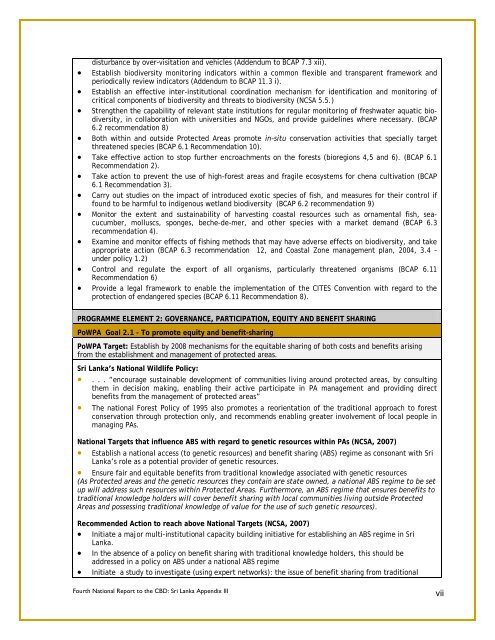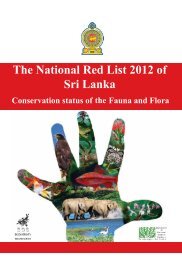stakeholder groups and communities.• Within ten years of the BCAP, 1999: Well-managed and rehabilitated wetlands, protected from urbandevelopment activities, and free of industrial polluti<strong>on</strong> and urban solid waste.• Within ten years of the BCAP, 1999: Marine and coastal c<strong>on</strong>servati<strong>on</strong> areas managed with theparticipati<strong>on</strong> of local communities.Recommended Acti<strong>on</strong> to reach Nati<strong>on</strong>al Targets• Complete the preparati<strong>on</strong> of management plans (including surveying and boundary marking) for allprotected areas; ensure that such plans c<strong>on</strong>tinue to recognize the participatory role of communitiesliving in proximity to the areas under protecti<strong>on</strong> and adequately address the c<strong>on</strong>servati<strong>on</strong> andsustainable use of biodiversity. (BCAP 6.1 Recommendati<strong>on</strong> 4)• Ensure that activities in forests outside Protected Areas are governed by management plans that payadequate attenti<strong>on</strong> to the c<strong>on</strong>servati<strong>on</strong> of endemic plants and animals. (BCAP 6.1 Recommendati<strong>on</strong> 9).• C<strong>on</strong>tinue to develop strategies and plans for the management of wetlands. (BCAP 6.2 Recommendati<strong>on</strong>1).• In collaborati<strong>on</strong> with relevant state agencies, user groups and communities, prepare management plansfor identified marine protected areas to c<strong>on</strong>serve biodiversity, and strengthen capabilities formanagement. (BCAP 6.3 Recommendati<strong>on</strong> 10)• Strengthen and expedite the preparati<strong>on</strong> and implementati<strong>on</strong> of the special area managementprogrammes identified in "Coastal 2000" and the CZM Plan of 1996, and extend the programmes to othercoastal sites as necessary. (BCAP 6.3 Recommendati<strong>on</strong> 28).• Prepare and implement management plans and strengthen capability am<strong>on</strong>g stakeholders forc<strong>on</strong>servati<strong>on</strong> and management of mangrove areas using a participatory approach (BCAP 6.3Recommendati<strong>on</strong> 11)• Actively implement the c<strong>on</strong>servati<strong>on</strong>-management plans of protected areas, giving due attenti<strong>on</strong> tobuffer z<strong>on</strong>e activities involving the peripheral communities (BCAP 6.1 Recommendati<strong>on</strong> 5)• Prepare suitable maps and implement the management plans for wetlands, taking into account the needfor collaborati<strong>on</strong> between the several state instituti<strong>on</strong>s c<strong>on</strong>cerned, including the provincialadministrati<strong>on</strong>, and based <strong>on</strong> participatory management principles. (BCAP 6.2 Recommendati<strong>on</strong> 3).• Establish a suitable mechanism for ensuring co-ordinati<strong>on</strong> in the management of protected areas and thec<strong>on</strong>servati<strong>on</strong> of biodiversity between the Forest Department and the Department of WildlifeC<strong>on</strong>servati<strong>on</strong> (BCAP 6.1Recommendati<strong>on</strong> 17).• Enhance field staff capability in pest management, protecti<strong>on</strong> against unlawful activities, and fireprotecti<strong>on</strong> (BCAP 6.1 Recommendati<strong>on</strong> 7)• The Forest Department and Department of Wildlife C<strong>on</strong>servati<strong>on</strong> to collaborate to strengthen theircapabilities in protected area management. (BCAP 6.1 Recommendati<strong>on</strong> 6).PoWPA Goal 1.5: To prevent and mitigate the negative impacts of key threats to protected areas.PoWPA Target: By 2008, effective mechanisms for identifying and preventing, and/or mitigating thenegative impacts of key threats to protected areas are in place.Nati<strong>on</strong>al Targets• Establish a system for m<strong>on</strong>itoring forest, wetland and coastal and marine biodiversity and takingcorrective acti<strong>on</strong> when necessary (MoFE, 1999).• Identify adverse impacts (including potential impacts) <strong>on</strong> the different comp<strong>on</strong>ents of biodiversity; totake acti<strong>on</strong> to mitigate such impacts and to avert potential adverse impacts (BCAP 5.3 (2)).• Capacity enhancement for m<strong>on</strong>itoring as a priority acti<strong>on</strong> to implement the CBD (NCSA thematicAssessment Report <strong>on</strong> biodiversity, MoENR, 2007).Recommended Acti<strong>on</strong> to reach Nati<strong>on</strong>al Target• Develop a system for the regular m<strong>on</strong>itoring of forest biodiversity, and take remedial acti<strong>on</strong> to rectifyany negative trends as and when necessary, including threats from invasive species (BCAP 6.1Recommendati<strong>on</strong> 1).• M<strong>on</strong>itor Protected Areas c<strong>on</strong>tinuously to ensure that uses are sustainable, especially polluti<strong>on</strong> andFourth Nati<strong>on</strong>al Report to the CBD: Sri Lanka Appendix IIIvi
disturbance by over-visitati<strong>on</strong> and vehicles (Addendum to BCAP 7.3 xii).• Establish biodiversity m<strong>on</strong>itoring indicators within a comm<strong>on</strong> flexible and transparent framework andperiodically review indicators (Addendum to BCAP 11.3 i).• Establish an effective inter-instituti<strong>on</strong>al coordinati<strong>on</strong> mechanism for identificati<strong>on</strong> and m<strong>on</strong>itoring ofcritical comp<strong>on</strong>ents of biodiversity and threats to biodiversity (NCSA 5.5.)• Strengthen the capability of relevant state instituti<strong>on</strong>s for regular m<strong>on</strong>itoring of freshwater aquatic biodiversity,in collaborati<strong>on</strong> with universities and NGOs, and provide guidelines where necessary. (BCAP6.2 recommendati<strong>on</strong> 8)• Both within and outside Protected Areas promote in-situ c<strong>on</strong>servati<strong>on</strong> activities that specially targetthreatened species (BCAP 6.1 Recommendati<strong>on</strong> 10).• Take effective acti<strong>on</strong> to stop further encroachments <strong>on</strong> the forests (bioregi<strong>on</strong>s 4,5 and 6). (BCAP 6.1Recommendati<strong>on</strong> 2).• Take acti<strong>on</strong> to prevent the use of high-forest areas and fragile ecosystems for chena cultivati<strong>on</strong> (BCAP6.1 Recommendati<strong>on</strong> 3).• Carry out studies <strong>on</strong> the impact of introduced exotic species of fish, and measures for their c<strong>on</strong>trol iffound to be harmful to indigenous wetland biodiversity (BCAP 6.2 recommendati<strong>on</strong> 9)• M<strong>on</strong>itor the extent and sustainability of harvesting coastal resources such as ornamental fish, seacucumber,molluscs, sp<strong>on</strong>ges, beche-de-mer, and other species with a market demand (BCAP 6.3recommendati<strong>on</strong> 4).• Examine and m<strong>on</strong>itor effects of fishing methods that may have adverse effects <strong>on</strong> biodiversity, and takeappropriate acti<strong>on</strong> (BCAP 6.3 recommendati<strong>on</strong> 12, and Coastal Z<strong>on</strong>e management plan, 2004, 3.4 –under policy 1.2)• C<strong>on</strong>trol and regulate the export of all organisms, particularly threatened organisms (BCAP 6.11Recommendati<strong>on</strong> 6)• Provide a legal framework to enable the implementati<strong>on</strong> of the CITES <str<strong>on</strong>g>C<strong>on</strong>venti<strong>on</strong></str<strong>on</strong>g> with regard to theprotecti<strong>on</strong> of endangered species (BCAP 6.11 Recommendati<strong>on</strong> 8).PROGRAMME ELEMENT 2: GOVERNANCE, PARTICIPATION, EQUITY AND BENEFIT SHARINGPoWPA Goal 2.1 - To promote equity and benefit-sharingPoWPA Target: Establish by 2008 mechanisms for the equitable sharing of both costs and benefits arisingfrom the establishment and management of protected areas.Sri Lanka’s Nati<strong>on</strong>al Wildlife Policy:• . . . “encourage sustainable development of communities living around protected areas, by c<strong>on</strong>sultingthem in decisi<strong>on</strong> making, enabling their active participate in PA management and providing directbenefits from the management of protected areas”• The nati<strong>on</strong>al Forest Policy of 1995 also promotes a reorientati<strong>on</strong> of the traditi<strong>on</strong>al approach to forestc<strong>on</strong>servati<strong>on</strong> through protecti<strong>on</strong> <strong>on</strong>ly, and recommends enabling greater involvement of local people inmanaging PAs.Nati<strong>on</strong>al Targets that influence ABS with regard to genetic resources within PAs (NCSA, 2007)• Establish a nati<strong>on</strong>al access (to genetic resources) and benefit sharing (ABS) regime as c<strong>on</strong>s<strong>on</strong>ant with SriLanka’s role as a potential provider of genetic resources.• Ensure fair and equitable benefits from traditi<strong>on</strong>al knowledge associated with genetic resources(As Protected areas and the genetic resources they c<strong>on</strong>tain are state owned, a nati<strong>on</strong>al ABS regime to be setup will address such resources within Protected Areas. Furthermore, an ABS regime that ensures benefits totraditi<strong>on</strong>al knowledge holders will cover benefit sharing with local communities living outside ProtectedAreas and possessing traditi<strong>on</strong>al knowledge of value for the use of such genetic resources).Recommended Acti<strong>on</strong> to reach above Nati<strong>on</strong>al Targets (NCSA, 2007)• Initiate a major multi-instituti<strong>on</strong>al capacity building initiative for establishing an ABS regime in SriLanka.• In the absence of a policy <strong>on</strong> benefit sharing with traditi<strong>on</strong>al knowledge holders, this should beaddressed in a policy <strong>on</strong> ABS under a nati<strong>on</strong>al ABS regime• Initiate a study to investigate (using expert networks): the issue of benefit sharing from traditi<strong>on</strong>alFourth Nati<strong>on</strong>al Report to the CBD: Sri Lanka Appendix IIIvii
- Page 1 and 2:
Fourth Country Report from Sri Lank
- Page 3:
Cover photo credits•••• Gra
- Page 6 and 7:
Chapter 22.1 Introduction ……392
- Page 8:
List of figuresFigure 1.1 Map of Sr
- Page 11 and 12:
Baseline Biodiversity Survey (BBS)
- Page 13 and 14:
through skills building for reporti
- Page 15:
Chapter 11.1 IntroductionThis chapt
- Page 19 and 20:
Figure 1.2: Major climatic zones ba
- Page 21 and 22:
Evolutionary significance of Sri La
- Page 23 and 24:
1.3 Species diversity1.3.1 StatusSr
- Page 25 and 26:
.11 Coastal and marine ecosystemsTA
- Page 27 and 28:
wetland habitats (MALF, 1995; IUCN
- Page 29 and 30:
Dry monsoon forests (Figure 1.3) lo
- Page 31 and 32:
woody species and faunal diversity
- Page 33 and 34:
TABLE 1.7: Trends in detection of i
- Page 35 and 36:
Bank, 2008), and are distributed th
- Page 37 and 38:
salt marshes occur along the coast
- Page 39 and 40:
Sri Lanka also has a range of cerea
- Page 41 and 42:
TABLE 1.8: Germplasm Collection Sta
- Page 43 and 44:
Soil erosion is extremely high in t
- Page 45 and 46:
1.8.5 Impact of changes in biodiver
- Page 47 and 48:
Chapter 22.1 IntroductionSri Lanka
- Page 49:
• The importance of Communication
- Page 53 and 54:
2.2.5 Institutional arrangements fo
- Page 55 and 56:
problem for non-implementation of t
- Page 57 and 58:
Key threats Specific issue Statusco
- Page 59 and 60:
Key threats Specific issue StatusSp
- Page 61 and 62:
TABLE 2.2: Major donor funded proje
- Page 63 and 64:
Chapter 33.1 IntroductionThe Confer
- Page 65 and 66:
Primary Stakeholders*Secondary stak
- Page 67 and 68:
laws concerning access to genetic r
- Page 69 and 70:
TABLE 3.3: Integration of biodivers
- Page 71 and 72:
Area of purviewPolicies / plans/ la
- Page 73 and 74:
Overall, biodiversity consideration
- Page 75 and 76:
SectorInstitutions, mandates and na
- Page 77 and 78:
Planning and policydevelopmentMonit
- Page 79 and 80:
oth western and traditional (i.e. A
- Page 81 and 82: the need for a mechanism to impleme
- Page 83 and 84: Stockholm Convention</stron
- Page 85 and 86: Chapter 44.1 Introduction4.1.1 The
- Page 87 and 88: 4.2.4. Evaluation of achieving targ
- Page 89 and 90: for declaration of PAs, and adoptio
- Page 91 and 92: • Programmes for ex-situ conserva
- Page 93 and 94: The crop wild relatives projectThe
- Page 95 and 96: WetlandsUnder the Wetland Conservat
- Page 97 and 98: active in detecting such illegal ex
- Page 99 and 100: ecause of anthropogenic factors suc
- Page 101 and 102: • Systematic gathering of atmosph
- Page 103 and 104: egion for over a week (Arulpragrasa
- Page 105 and 106: FOCAL AREA: MAINTAIN GOODS AND SERV
- Page 107 and 108: FisheriesThe national marine fisher
- Page 109 and 110: • Health and well being of rural
- Page 111 and 112: • The MoENR has formulated a nati
- Page 113 and 114: 4.3 Impact of NBSAPs and related se
- Page 115 and 116: Strategic goalsScale ofagreementSri
- Page 117 and 118: Strategic goalsScale ofagreementSri
- Page 119 and 120: Ministry of Environment & Natural R
- Page 121 and 122: Appendix II - Further sources of in
- Page 123 and 124: 62. Fernando, N. (1997) A Personnal
- Page 125 and 126: 133. MoENR, 2007b. The Thematic Ass
- Page 127 and 128: Appendix IIIProgress towards Target
- Page 129 and 130: .2.1 Protected Areas under the DWLC
- Page 131: National Target (NCSA 3 5.7, 2007)I
- Page 135 and 136: PoWPA Target: By 2008, sufficient f
- Page 137 and 138: Project (2001-2008)Other Policies,
- Page 139 and 140: There is no overall policy to guide
- Page 141 and 142: The ADB funded Forest Resources Man
- Page 143 and 144: Status of actions taken/in progress
- Page 145 and 146: The Community Participation Project
- Page 147 and 148: B.4.8 PoWPA Goal 3.2 - To build cap
- Page 149 and 150: B.5 Overview of obstacles for imple














